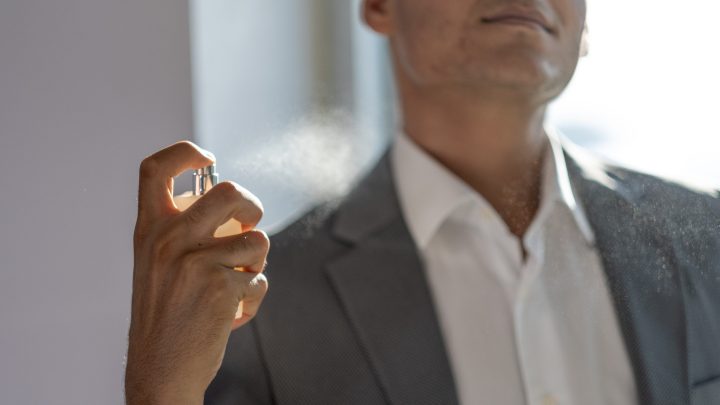
What’s that smell? A teenage boy wearing luxury cologne.

Earlier this year, the trend of tween and teen girls flocking to cosmetic stores for high-end skin care products made headlines. But as Callie Holtermann recently reported for The New York Times, teen boys are obsessing over an adjacent category of merch: luxury cologne.
Use the media player above to hear her conversation with “Marketplace” host Kai Ryssdal about why adolescent boys are splurging on fancy fragrances. An edited transcript is below.
Kai Ryssdal: How did you come upon this story? Because teenage boys and luxury cologne does not compute for me.
Callie Holtermann: Yeah, and I’m not a teenage boy, I should say.
Ryssdal: Nor am I, but I was once, and it didn’t compute for me back then either.
Holtermann: Totally. I heard about the beginning of this story from two of my colleagues, both of whom have teenagers, and they were talking about hearing that teenage boys their kids’ age were really, really into these high-end colognes. And I have to say, I was really surprised when I heard that because I was thinking back to my own teenage days. People were into cologne, but it was not the good stuff — it was Axe.
Ryssdal: Sorry to laugh. One doesn’t think of Axe when one thinks of cologne. We’re talking high end here. These are, like, $300 bottles of cologne.
Holtermann: Yeah. For comparison, a bottle of Axe, the body spray that was really popular among teenagers in the early 2000s, that’s about $7 for 5 ounces. Some of these colognes that these kids were talking about were things like Jean Paul Gaultier Le Male, which is around $152 for a similar amount, all the way up to Tom Ford’s Tobacco Vanille, which is $445 for 3.4 ounces.
Ryssdal: Oh, man. Sorry, this whole story has just set me back a tad. The fact that these things cost $300-$400 a bottle does sort of make it a very specific set of kids who can afford this, you know? With their parents’ help, right?
Holtermann: Totally. Yeah, this is not all kids in the slightest. It’s definitely happening among wealthier families. At the same time, one thing I’ll note is that I spent a lot of time in Sephora and Ulta and at different fragrance counters while reporting this story. And the thing about fragrances is anybody can get a free sample. And a lot of the people who worked at those fragrance counters said, you know, even the kids who are not able to buy this kind of perfume or cologne are often coming in and getting tests of all these different scents.
Ryssdal: What do the brands themselves have to say about this? Because, you know, it’s not like, well, they want everybody to be wearing it, but they want everybody in a certain, you know, strata to be wearing their brands, right? Not necessarily, you know, kids who smell like a locker room.
Holtermann: Exactly. Well, interestingly, the brands have very little to say about this. I reached out to a lot of them, and not one of the brands got back to me, which signals to me, perhaps, that there’s a little bit of uneasiness about being associated with a really young customer. Although it’s sort of an open secret, and one spending analyst told me this, that it’s really profitable for these brands to be getting in the hands of really young people. Cologne is the kind of thing that someone will select maybe at 15 or 16 or 18 [years old], and they might stick to that brand for life. So, companies do sort of compete, and they have this race to the bottom with age, it seems, but they don’t want to admit it.
Ryssdal: Just on the, on the, you know, “kids today” note, it’s not terrible that teenage boys are doing this as opposed to, you know, sitting there staring at their screens all day, right?
Holtermann: I mean, it was really interesting talking to parents. There were some parents who were concerned about kind of the marketing that was happening with their kids, and that, you know, their kids were coming to them and feeling like they needed this really expensive stuff. There were other parents who said, “You know what? There’s a lot of concerning stuff that my 15-year-old boy could be getting up to. There are a lot of scary online forums he could be in.” And if the online forum that he’s in is Fragrantica and he’s talking about “base notes” with other 15-year-olds, they’re like, that’s a little more harmless than some of the other stuff.
Ryssdal: Right. There’s also just, sorry, speaking of screens, there’s this influencer, I think he’s a German guy, I can’t remember the name — he’s got, like, 8 million followers on TikTok or something.
Holtermann: Approaching 9 million followers. His name is Jeremy Fragrance. He’s kind of the big name in the fragrance influencer space. A lot of the young men I spoke to kind of really look up to him or idolize him or watch all his videos. He does things like show off his Rolex and his Ferrari and talk about the importance of brands and the way that these colognes can sort of make you seem perhaps more masculine or more mature to the people you’re around.
There’s a lot happening in the world. Through it all, Marketplace is here for you.
You rely on Marketplace to break down the world’s events and tell you how it affects you in a fact-based, approachable way. We rely on your financial support to keep making that possible.
Your donation today powers the independent journalism that you rely on. For just $5/month, you can help sustain Marketplace so we can keep reporting on the things that matter to you.











